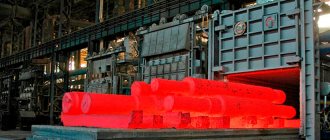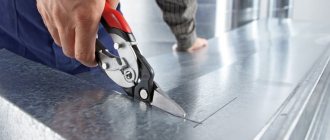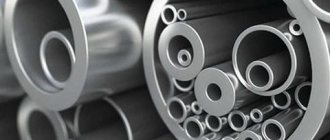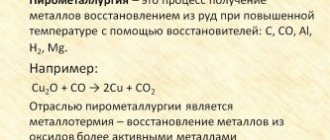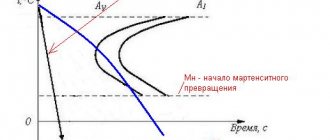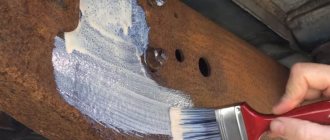The need for surface hardening and tempering
Surface hardening of parts is done to achieve better characteristics of the outer layer, while in the core the metal remains tough and ductile. In this way, it is possible to change the physical and mechanical properties of the metal.
To reduce brittleness and residual stresses, the metal is then tempered, after which its hardness decreases slightly and its properties become more stable.
The steel surface hardening temperature is 820-900 0C. It can be distinguished by color.
To obtain the required depth of heat treatment, after rapid heating, the surface of the part is cooled with air or water.
Surface hardening
Some parts require high hardness and wear resistance of the surface in combination with good toughness in the core during operation. This applies to parts operating under wear conditions with the simultaneous action of dynamic loads (for example, gears, fingers, fastening track links of tracked vehicles).
In such cases, not the entire part is subjected to hardening, but only a thin (several mm) surface layer.
Surface hardening is heating only the surface layer of a part to quenching temperatures, followed by rapid cooling and the formation of a martensitic structure only in this layer.
Such hardening is carried out by rapid heating of the surface, during which the core does not have time to warm up due to thermal conductivity. With such heating, the temperature across the cross section of the part drops sharply from the surface to the center.
After cooling, three characteristic zones with different structures and properties are obtained in the section of the part (Fig. 46).
a b c
Fig. 46. Surface hardening of steel:
A
– temperature distribution across the section;
b
– structure during surface heating;
V
– structure after hardening
In zone I, after quenching, a martensitic structure with maximum hardness is obtained, since this zone was heated above the critical temperature Ac3.
In zone II, after quenching, in addition to martensite, the structure will also contain ferrite. Consequently, the hardness there will be lower.
In zone III, heating and cooling do not lead to any changes in the structure. This means that the original ferrite-pearlite structure with low hardness but high plastic properties is preserved here.
After case hardening, the part can resist dynamic loads due to its tough core and perform well under wear conditions due to its hard surface.
The rapid heating of the surface, necessary with this technology, is most often carried out by induction (High-frequency hardening). The part is placed in an inductor connected to a high-frequency current generator (Fig. 47). An alternating high-frequency magnetic field induces eddy currents in a thin surface layer of metal, and heating is carried out due to the resistance of the metal to the flow of these currents. Immediately after heating, which lasts for seconds, the part is placed in a sprayer to cool.
Fig.47. HDTV hardening scheme
Surface hardening must be accompanied by low tempering.
The higher the frequency of the external alternating magnetic field, the thinner the layer in which the eddy currents are concentrated. Therefore, the depth of the hardened layer can be easily adjusted and ranges from tenths of a millimeter to 3–5 mm. The HDTV hardening operation can be fully automated. The method is very productive; warping and oxidation of the surface of the part is minimal.
Sometimes, for surface hardening, other heating methods are used - gas flame (Fig. 48), laser, and also heating by short-term immersion in molten salts.
Fig. 48. Scheme of gas-flame hardening
For the surface hardening method, special steels with reduced hardenability have been created, for example, 55PP (0.55% C and no more than 0.5% impurities).
Gas flame hardening
The temperature regimes associated with heating and cooling can be continuous or cyclical. Surface hardening is performed in four ways.
- Heating and cooling of a part area: hardening of wheel teeth, rail ends, valves, etc.
- Hardening of small rotating bodies with a small width of the treated area: axle and shaft journals.
- Continuous-sequential method: moving a flame along the surface, followed by a coolant. Sequential heating and cooling of narrow areas with water jets is carried out. The surfaces of large-diameter parts are similarly hardened with their slow rotation relative to stationary burners and nozzles. Temper zones remain at the edges of the strips during secondary heating from neighboring areas.
- Combined method: moving along the generatrix of the flame jets, and behind them - the cooling medium while rotating the cylindrical part. The technology is used for hardening long products. The method provides a uniform solid layer on the surface of the part.
Flame hardening technology
Surface hardening is carried out on machines where the processes of moving heating and cooling devices and parts are mechanized. The process is widely used in industry. It requires simple devices. A mixture of acetylene and oxygen, natural gas or kerosene is used as an energy source. Sometimes gas-flame heating is more profitable to use than high-frequency heating. This especially applies to large-sized products for which it is difficult to manufacture inductors. The method is often used in small-scale production, when high demands are not placed on the quality of parts. Injection-type quenching burners contain replaceable tips for adjusting the flame power. Mouthpieces are made in accordance with the profile of the parts being processed. They are made with a large number of nozzles or slotted ones. Jet sprinklers supply water for cooling.
Mechanisms for moving tools and parts are used specialized or universal. Enterprises often manufacture them on their own using metalworking machines.
Hardening of metals depends on the composition, as well as on the size and shape of the products.
Process parameters
The adjustable parameters are as follows.
- Heating power. It depends on the acetylene consumption and the speed of the flame relative to the product.
- The distance from the center of the torch to the heated surface is maintained at a level of 2 to 3 mm.
- Duration of heating or speed of movement of the heater. The depth of hardening and surface hardness depend on these characteristics, which are selected experimentally.
- Water with a temperature of 18-350C is mostly used as a coolant, and the flow rate is about 1 l/cm2.
- Time between heating and cooling (5-10 sec) or distance between heating and cooling zones (12-25 mm).
Steel hardening technology includes the processes of heating the metal, holding it to equalize the temperature while undergoing the necessary structural transformations, and cooling at a given speed. A distinctive feature of surface hardening is rapid heating.
Preparation of parts before hardening involves smoothing out sharp corners and cleaning in various ways: sandblasting, chemical, or manual brushes.
Surface hardening under the correct conditions ensures an increase in the durability of parts by 2-5 times. The choice of cooling modes allows you to smoothly increase the hardness of the hardened layer up to 700 HB. The process should go quickly. At the final stage, when the temperature is 200-3000C, the cooling rate slows down. As a result, the formation of cracks is reduced and the products do not warp.
When alloy steels are overheated, the hardness may decrease, which is considered as a defect. There is also no possibility of precise adjustment of the thickness of the hardened layer. In addition, when working with gas, additional measures are required to ensure safe working conditions.
Educational materials
Surface hardening is one of the ways to increase the hardness of the surface layers of a product, while its core remains unhardened (soft viscous) and absorbs shock loads well.
Surface hardening is carried out by induction heating with high frequency current (HF), gas flame, or laser beam heating.
Hardening with induction heating. Induction heating occurs due to the thermal effect of a current induced in a product placed in an alternating magnetic field.
To heat the product, it is installed in an inductor (solenoid), which is one or several turns of a hollow water-cooled copper tube or bus (Figure 43).
a - distribution of magnetic flux in the inductor;
b - direction of currents in the inductor and parts;
1- heated part; 2- turn of inductor; 3- magnetic lines of force.; 4 - direction of current in the indicator; 5 - direction of current in the part
Figure 43 - Induction heating circuit
Alternating current flowing through the inductor creates an alternating magnetic field. As a result of induction, vortex points appear in the surface layer and Joule heat is released in the layer of the workpiece. The current passes mainly in the surface layer of the metal.
About 90% of the heat is released in a layer of thickness X (m):
where f is the current frequency, Hz; r - electrical resistance of the part material, Ohm×m; m - magnetic permeability, G/m.
For hardening, relatively high power is used (0.1...2.0 kW/cm2), and therefore the heating time is 2...50 s. To obtain a layer 1 mm thick, the current frequency is 50...60 kHz, for a layer 2 mm thick - 15 kHz and for a layer 4 mm thick - 4 kHz. It is usually believed that the cross-sectional area of the hardened layer should be no more than 20% of the total cross-section. After heating in the inductor, the part is quickly moved into a special cooling device - a sprayer, through the holes of which the quenching liquid is sprayed onto the heated surface; sometimes heated parts are dumped into quench tanks.
A high heating rate shifts phase transformations to the region of higher temperatures, therefore the quenching temperature when heating with high-frequency heat for the same steel should be higher than during volumetric quenching.
It is most advisable to use this method for heating products made of carbon steels containing more than 0.4% C. For alloy steels, high-frequency frequencies are, as a rule, not used, since one of their advantages - the deep hardenability of alloy steels - is not used with this method.
The advantage of the HDTV method is high productivity, the absence of decarburization and oxidation of the surface of the part, the ability to regulate and control the heat treatment mode, as well as complete automation of the entire process.
The disadvantage is the high cost of induction installations and inductors (each part has its own inductor), so this method is economically feasible to use only in the mass production of similar parts of a simple shape.
Quenching with gas-flame heating. This hardening method is used for large products (rolls, pipes, shafts, etc.). The surface of the part is heated with a gas flame having a temperature of up to 3150 0C. Acetylene, natural gas, and kerosene are used as flammable gases. For heating, slot burners (having one slot-shaped hole) and multi-flame burners are used.
The thickness of the hardened layer is usually 2...4 mm, and its hardness for steel with 0.45...0.5% C is 50...56 HRC. The flame hardening process can be automated and integrated into the overall machining flow. For large parts, this hardening method is often more cost-effective than induction hardening.
Surface hardening by laser heating. It is one of the widely used types of laser processing of metals and alloys. It is based on local heating of a surface area by a laser light beam and cooling of this area at a supercritical speed due to heat removal into the inner layers of the metal. In this case, there is no need to use cooling media, which significantly simplifies the thermal strengthening technology. The thickness of the hardened layer does not exceed 1.5...2.0 mm.
Defects arising during heat treatment of steel > Continue >
Hardening with high frequency currents (HFC)
High-frequency heating is one of the most effective ways to harden a surface. The use of high frequency frequencies up to 10 thousand kHz significantly reduces the heat treatment time. A high-frequency current is passed through a water-cooled copper inductor. The resulting electromagnetic field penetrates the steel part, forming eddy currents in it, thereby causing heating. The main energy is concentrated in the surface layers. The depth of heating depends on the magnetic permeability of the steel, electrical resistance and current frequency. By adjusting these parameters, you can change the size of the hardened layer.
Basic methods of surface hardening of steels
- Surface induction hardening of steels is based on placing the product near an alternating current source - an inductor. At the same time, the metal is affected by an electromagnetic field, which excites an electromotive force in the metal and causes an alternating current to pass through it at the same frequency as the inductor current. The current is induced in the surface layer of the part and causes it to heat up.
- Flame or gas-flame hardening of metal. It is based on heating the metal surface with a gas flame. With this hardening method, hardened layers with a depth of 2-4.5 mm are obtained.
- Laser hardening is based on the use of laser radiation, which creates high thermal field densities on a surface area. With laser hardening, a layer of less than 1 mm is usually obtained.
Advantages of the induction method
- high productivity and economical heating when it is necessary to heat only certain areas of parts;
- the surface of the part is slightly oxidized, there is no decarburization;
- products warp less, fewer cracks form;
- The depth of hardening is precisely adjusted;
- possibility of process automation.
The disadvantages of the HDTV hardening method include the high cost and complexity of manufacturing induction devices.
Copper inductors are manufactured with or without damping devices.
There are the following types of surface hardening.
- Simultaneous. After heating, the part is cooled with water. The part being hardened is heated inside the inductor. After a predetermined time, the electric current is turned off and water is supplied in strong jets through the heater holes to cool the product. Ring inductors are used for hardening gears, and loop or zigzag inductors are used for flat parts.
- Continuous-sequential. A heating inductor moves along the stationary part, followed by a showering device.
HDTV heating makes it possible to create automated units in the flow of machining shops. Due to this, there is no need to transport parts to heat treatment shops.
Types of metal hardening
Based on the cooling method, the following types of hardening are distinguished.
Quenching in one environment
This type of hardening is easier to perform, but it cannot be used for any steel and not for all products.
Rapid cooling in a wide temperature range of products of variable cross-section contributes to the occurrence of temperature unevenness and large internal stresses, called thermal.
In addition to thermal stresses, during the transformation of austenite into martensite, additional so-called structural stresses
, due to the fact that the transformation of austenite into martensite occurs with an increase in volume.
If the part has a complex shape or variable cross-section, then the increase in volume occurs unevenly and causes the occurrence of internal stresses.
The presence of large stresses can cause warping of the product, lead, and sometimes cracking if the magnitude of internal stresses exceeds the tensile strength.
The more carbon, the greater the volumetric changes and structural stresses, the greater the risk of cracks.
Steel with a carbon content of more than 0.8% is hardened in one environment if the products are of simple shape (balls, rollers, etc.). Otherwise, they prefer hardening either in two environments, or using the step hardening method.
Hardening in two environments
This method has found wide application for hardening high-carbon steel
.
It consists of the following:
- the part is first soaked in water and cooled to temperatures of 500-550°,
- then quickly transferred to oil, where it is left until completely cooled.
Step hardening
With this method, the part is quickly cooled by immersion in a salt bath with a temperature of 300-250°. Hold at this temperature for 1.5-2 minutes. should ensure equalization of temperatures throughout the entire cross-section of the product, thereby eliminating thermal internal stresses. Subsequent cooling is carried out in air.
As a cooling medium
They use molten salts, nitrate, and fusible metals.
Step hardening
reduces internal stress, warping and the possibility of cracking of parts.
Disadvantages of step hardening
The disadvantage of this type of hardening is that cooling in hot environments cannot provide a high cooling rate in the range of 400-600°.
In this regard, step hardening for carbon steel can be used for small cross-section products (diameter up to 10 mm,
for example, drills).
For alloy steels
, having small values of the critical hardening rate, step hardening is applicable to products of larger cross-section.
Hardening with cooling
With this method, the part is removed from the oven and kept in air for some time before being immersed in the coolant. The exposure time in air should be such that
decomposition into the structure of perlite or sorbitol. This time is determined by the practice of hardening.
Cooling down
reduces internal stresses and warping and is used for thin and long parts.
Surface hardening of steel
Some parts in operation require high surface hardness while maintaining a sufficiently viscous core, for example, a gear tooth, a crankshaft journal, etc.
In this case, the steel is deliberately hardened to a shallow depth. There are several methods for surface hardening steel.
Surface hardening when heated with an acetylene-oxygen flame
The product is heated with an acetylene-oxygen flame. A flame burner (Fig. 67), moving along the product at a certain speed, heats its surface.
Following the burner, a tube moves at the same speed, supplying water, with the help of which the product is cooled.
Warm-up depth
and heating temperature are regulated by the speed of movement of the burner and the distance of the burner from the product.
Surface hardening with high frequency currents
Heating of products by high frequency currents causes heating of the surface layer of the product.
This is explained by the fact that high-frequency currents spread with uneven density across the cross section.
The higher the frequency of the current, the shallower the depth of the product the currents penetrate.
Due to this, a high current density occurs at the surface of the product, causing very rapid heating of the surface layers of the metal.
This method has several advantages:
high productivity, sufficient ease of adjusting the depth of the hardened layer, obtaining greater hardness than with conventional hardening methods, absence of scale and warping.
The electric current used for this purpose is obtained from special generators that provide alternating current with a frequency of up to 10 million Hz
(i.e. changes in current direction per second).
The city network current has a frequency of 50 Hz.
The product is heated by an inductor
, through which currents of high frequency and great strength pass.
The inductor induces (induces) currents in the product placed inside it (Fig. 68).
The inductor is made of hollow copper tubes, inside which cooling water circulates, so it itself does not heat up in the short period of time during which the part manages to heat up to the required temperature.
Inductor shape
must accurately repeat the shape of the product, only then will the product be hardened to the same depth throughout the entire cross-section. Difficulties arise when the part has a complex shape, which limits the use of this method.
Cooling a heated part
most often carried out either by an additional rain device or
by water
circulating inside the inductor.
Due to the fact that a new type of part requires the manufacture of a new inductor, this method is advisable to use when there are parts of the same type in mass or large-scale production.
§
Other methods of surface hardening of steel
- Quenching in electrolyte. If an electric current is passed through an aqueous electrolyte solution, the cathode is a part that heats up quickly. The method is convenient because after a power outage the part is immediately hardened. The electrolyte bath simultaneously functions as a heating furnace and a quenching tank.
- Laser hardening. Laser radiation heats the metal surface to a high temperature. The reinforcement thickness is less than 1 mm. The wear resistance of cast iron parts increases several times, and the endurance limit of steel increases to 80%. The method is often used to harden the cutting edges of a tool.
Methods of hardening. Types of surface hardening.
⇐ PreviousPage 6 of 15Next ⇒
Many critical parts (shafts, gears, etc.) operate on friction and are simultaneously exposed to shock loads. Such parts must have a hard surface layer with high wear resistance and a viscous core that provides impact resistance.
To ensure these requirements, various methods of surface hardening and surface hardening are used.
Surface hardening is the heating of the surface layer of a part to the hardening temperature and subsequent rapid cooling.
Surface hardening, depending on the method of heating parts, is divided into the following types:
1) induction (t.v.h.) according to the method of prof. V. P. Vologdina;
2) contact (according to the method of Prof. N.V. Haveling);
3) gas-flame;
4) hardening in an electrolyte (according to the method of I.Z. Yasnogorodsky).
Induction hardening is based on a physical phenomenon, the essence of which is that a high-frequency electric current, passing through a conductor (inductor), creates an electromagnetic field around it. Eddy currents (Foucault currents) are induced on the surface of a part placed in this field, causing the metal to heat to high temperatures. This makes it possible for phase transformations to occur, i.e., the transformation of pearlite into austenite. After cooling, the surface of the part has a martensite structure.
The main factors in electric heating are heating temperature, heating rate and current penetration depth.
The temperature and heating rate depend on the amount of heat released according to the Joule-Lenz law:
Q = 0.24 I2Rt,
where Q is the amount of heat in J (cal);
I - current strength in a;
R—conductor resistance in ohms;
t is the time of exposure to current in seconds. By changing the current, you can adjust the heating temperature and heating speed. By adjusting the frequency of the current, you can obtain any thickness of the hardened layer (in practice, the hardened layer is allowed up to 3 mm).
Machine generators are used to generate current when hardening large parts. Lamp generators are used to harden small parts.
Inductors are made of red copper. They are single-turn and multi-turn. To avoid overheating, they are made hollow for cooling with water.
a - simultaneous heating of the entire surface; b - sequential hardening; c - continuous-sequential hardening
Depending on the heating method, induction hardening is divided into three types (Fig. 35):
simultaneous heating and hardening of the entire surface (used for small parts);
sequential heating and hardening of individual sections (used for crankshafts and similar parts);
continuous-sequential heating and quenching by movement (used for long parts).
The advantages of the induction hardening method are as follows:
1) high process productivity;
2) ease of automation of the process and the possibility of including a heat treatment operation in the general flow of parts manufacturing;
3) greater efficiency of the process compared to other types of surface hardening;
4) obtaining good mechanical properties of the part;
5) the absence of a decarburized and oxidized layer in the hardened surface (therefore, the operation of descaling is eliminated and the processing allowances can be reduced);
6) minimal deformation of parts, and therefore the need to eliminate straightening of hardened parts or reduce straightening time.
The disadvantages of the induction hardening method are as follows:
1) the need for individual inductors;
2) relatively high initial price of HDTV installations;
3) the absence of a temperature stabilizer that allows for reliable and accurate holding at the hardening temperature;
4) the absence of a stabilizer for the electrical mode of the generator in most installations.
Surface hardening t.v. up to 60% of hardened carbon steel parts in large-scale and mass production plants are subjected to hours.
Surface hardening during contact heating is based on the fact that current from the network through a step-down transformer 1 is supplied to copper electrodes made in the form of rollers 2 (Fig. 36), which roll over the surface of part 3 and heat it.
In this case, the part serves as a resistance connected to the circuit. Following the rollers, a device for cooling the part moves. The depth of the hardened layer depends on the speed of movement. Thus, to obtain a hardening depth of 2–3 mm, the roller speed is 5–8 mm/sec. Welding transformers (power from 25 to 200 kW) are used to heat the surface.
There are two methods of surface hardening during contact heating:
1) hardening with a wide roller across the entire width of the hardened surface;
2) tape processing.
The latter is used for long parts.
A disadvantage of the surface hardening method during contact heating, especially for strip processing, is the presence of tempering strips with reduced hardness, which are formed as a result of the fact that when the next strip is heated, the already hardened spiral located nearby is tempered.
The advantage of the method is ease of installation. The considered method is used for parts of simple design.
The process of gas-flame hardening consists of quickly heating the surface of a part with an acetylene-oxygen, gas-oxygen or oxygen-kerosene flame to the hardening temperature, followed by cooling with water or emulsion.
Large, simple-shaped parts made of carbon steel are subjected to gas-flame hardening.
The advantages of gas-flame hardening are as follows:
a) low installation cost;
b) the ability to automate the process and include the heat treatment operation in the overall flow of part manufacturing;
c) the absence of a decarburized and oxidized layer in the hardened surface.
The disadvantage of gas-flame hardening is the difficulty of regulating the heating temperature and the depth of the hardened layer.
The process of hardening in an electrolyte is as follows: a steel part is lowered into a bath of electrolyte (5-10% Na2CO3 solution) and a current of 250-350 V is passed through. The anode is the bath, and the cathode is the steel part. A hydrogen jacket with very high electrical resistance is formed around the cathode - the part. As a result, the hydrogen jacket quickly heats up to 1800–2000 ° C and the part is heated to a temperature above the Ac3 point in a few seconds.
The part is cooled either in the same electrolyte (after turning off the current) or in a special quenching tank.
The advantages of the method are as follows: simplicity of the installation device; possibility of simple installation automation; possibility of local hardening (individual parts of the part).
Disadvantages of electrolyte hardening: application for a limited number of parts; the need to protect parts from corrosion; uneven heating of the surface of the part due to uneven distribution of current density.
Cold processing of steel.
Cold treatment consists of immersing hardened parts for some time in an environment with a temperature below zero. After this, the parts are taken out into the air.
The holding time during cold treatment is determined by the time required to completely cool the entire part and equalize the temperatures across the cross section.
Cooling of the product to negative temperatures is carried out in a mixture of solid carbon dioxide (dry ice) with alcohol, which gives cooling to -78.5°, or in liquid nitrogen (-196°).
In addition, refrigeration units are used that allow the temperature of the working chamber to be varied within wide limits.
Cold treatment is used for steels in which retained austenite remains after hardening (carbon steel containing more than 0.6% C, alloy tool steel).
The result of cold metal processing
As a result of cold processing, due to the transformation of retained austenite into martensite, hardness and wear resistance increase, and therefore this type of processing is used in the manufacture of tools.
In addition, cold processing stabilizes the dimensions of parts, and therefore this treatment is used for measuring tools and precision machine parts.
⇐ Previous6Next ⇒
Recommended pages:
Use the site search:
Tempering after hardening
Hardening and tempering are two processes that complement each other and ensure the production of high-quality parts. The purpose of tempering is the final operation after hardening, forming the final, more stable properties of the metal, ensuring the removal of internal stresses. A steel product of a certain grade is heated and maintained at the appropriate temperature, after which it is cooled in air.
- Low tempering at 120-2500C - processing of tools and other parts. The metal has a stable structure, high wear resistance and hardness.
- Average tempering at 350-5000C - for dies, springs, leaf springs. The structure has good plasticity and high elasticity.
- High tempering at 500-6800C - medium-carbon structural steels. Provides high strength, toughness, and plasticity.

